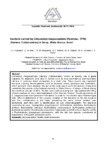Use este identificador para citar ou linkar para este item:
http://www.alice.cnptia.embrapa.br/alice/handle/doc/1003186Registro completo de metadados
| Campo DC | Valor | Idioma |
|---|---|---|
| dc.contributor.author | CARNEIRO, J. S. | pt_BR |
| dc.contributor.author | PIRES, E. M. | pt_BR |
| dc.contributor.author | NOGUEIRA, R. M. | pt_BR |
| dc.contributor.author | SHIOMI, H. F. | pt_BR |
| dc.contributor.author | SOARES, M. A. | pt_BR |
| dc.contributor.author | OLIVEIRA, M. A. | pt_BR |
| dc.contributor.author | MELO, I. S. de | pt_BR |
| dc.date.accessioned | 2014-12-18T11:11:11Z | pt_BR |
| dc.date.available | 2014-12-18T11:11:11Z | pt_BR |
| dc.date.created | 2014-12-18 | pt_BR |
| dc.date.issued | 2014 | pt_BR |
| dc.identifier.citation | Scientific Electronic Archives, Sinop, v. 6, p. 18-22, 2014. | pt_BR |
| dc.identifier.uri | http://www.alice.cnptia.embrapa.br/alice/handle/doc/1003186 | pt_BR |
| dc.description | Abstract: Chrysomya megacephala (Diptera: Calliphoridae), known as blowfly, has a great capacity for dispersion and, due to factors such as food abundance and favorable climate, it colonizes Brazil completely in a short time. These insects are important because carrying microorganisms such as bacteria, viruses, protozoa and helminthes, which promote many diseases. The aim of this study was to verify the diversity of bacteria carried by this species in the Federal University of Mato Grosso ? Campus of Sinop during the month of January of 2012. The flies were collected using two traps baited with 100 g of fresh sardines on each and maintained in the field for 24 hours. Twenty specimens of C. megacephala were placed in Petri dishes, to walk for two minutes upon Nutrient Agar (NA). After establishment of the colonies, isolation of the bacteria on the NA medium and their multiplication in test tubes containing the same culture medium was performed, and later sent to identification by gas chromatography. The bacteria encountered were Aquaspirillum polymorphum; Burkholderia ambifaria; Burkholderia anthina; Burkholderia cepacia; Burkholderia cenocepacia; Burkholderia pyrrocinia; Burkholderia stabilis; Paenibacillus macerans; Virgibacillus pantothenticus, Bacillus subtilis e Photorhabdus luminescens luminescens, with the last two species considered of importance in the plant protection sector. | pt_BR |
| dc.language.iso | eng | eng |
| dc.rights | openAccess | eng |
| dc.subject | Health | pt_BR |
| dc.title | Bacteria carried by Chrysomya megacephala (Fabricius, 1794) (Diptera: Calliphoridae) in Sinop, Mato Grosso, Brazil. | pt_BR |
| dc.type | Artigo de periódico | pt_BR |
| dc.date.updated | 2015-01-07T11:11:11Z | pt_BR |
| dc.subject.thesagro | Bactéria | pt_BR |
| dc.subject.thesagro | Chrysomya megacephala | pt_BR |
| dc.subject.thesagro | Môsca varejeira | pt_BR |
| dc.subject.nalthesaurus | Microorganisms | pt_BR |
| dc.subject.nalthesaurus | Calliphoridae | pt_BR |
| dc.subject.nalthesaurus | plant protection | pt_BR |
| riaa.ainfo.id | 1003186 | pt_BR |
| riaa.ainfo.lastupdate | 2015-01-07 | pt_BR |
| dc.contributor.institution | J S CARNEIRO, UFMT; EVALDO MARTINS PIRES, UFMT; R M NOGUEIRA, UFMT; HUMBERTO FRANCO SHIOMI, UFMT; M A SOARES, UFVJM; M A OLIVEIRA, UFV; ITAMAR SOARES DE MELO, CNPMA. | pt_BR |
| Aparece nas coleções: | Artigo em periódico indexado (CNPMA)  | |
Arquivos associados a este item:
| Arquivo | Descrição | Tamanho | Formato | |
|---|---|---|---|---|
| 2014AP023.pdf | 261,03 kB | Adobe PDF |  Visualizar/Abrir |









